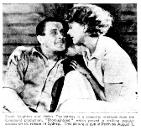AustLit
The material on this page is available to AustLit subscribers. If you are a subscriber or are from a subscribing organisation, please log in to gain full access. To explore options for subscribing to this unique teaching, research, and publishing resource for Australian culture and storytelling, please contact us or find out more.
Film Details - Cinesound Productions , 1936
Producers:
Ken G. Hall
Production Companies:
Cinesound Productions
Director of Photography:
George Heath
Editors:
William Shepherd
Production Designers:
Fred Finlay (Art Director)
Music:
W. Hamilton Webber (Music Director)
Cast:
Incl. Helen Twelvetrees (Joan), Frank Leighton (Tommy Dawson), John Longden (Bill Peel), Nellie Barnes (Judy Cross), Elaine Hamill (Linda), Ron Whelan (Genna), Les Warton (Grafter), Harold Meade (Sir Russell Peel), Nellie Ferguson (Ma Dawson), George Lloyd (Sleepyfeet), Lynton Moore (Hops Warton), John D'Arcy (Jack Dent), Alf Stanton (Midget Martin), Jack Settle (Honest Herman), Pearl Hellmrich (Mrs Dinwiddle), Edmond Seward (Mr Terry), Paul Marcus (Frenchman), Don McNiven.
Release Dates:
1. May 1936 (Mayfair Theatre, Sydney)
2. Released on videocassette format in 1989 by the National Film and Sound Archive.
Notes:
1. Produced on a budget of £20,000, Thoroughbred was the first film made by Ken G. Hall following his six-month visit to Hollywood. The trip was undertaken both to study new filmmaking techniques and to purchase new equipment. In this respect, Thoroughbred was the first Australian film to utilise a rear projection unit, which enabled Hall to stage action in the studio in front of moving backgrounds (thus saving the expense of moving the whole production out to remote locations).
2. The film was well received by critics and audiences in Australia but ran into difficulties in Great Britain, where the censor objected to what it perceived as animal cruelty (notably the stable fire). A number of scenes were ordered to be cut from the film despite Hall's protests that the fire had been filmed with the rear projection unit and that no horses had been exposed to the fire. The scene cutting subsequently caused narrative continuity problems and the film failed to arouse much interest among UK audiences and critics.
3. Former Hollywood silent-film star Helen Twelvetrees was engaged by Ken G. Hall to appear in the film despite her flagging popularity. Cinesound put together a carefully orchestrated publicity campaign to counter Twelvetrees's perceived B-grade status and the actress was enthusiastically received by the Australian public. The campaign also created much interest in the film both before production began and after the film's release.
4. Further reference: Andrew Pike and Ross Cooper. Australian Film 1900-1977, A Guide to Feature Film Production (1980), pp. 226-227.



